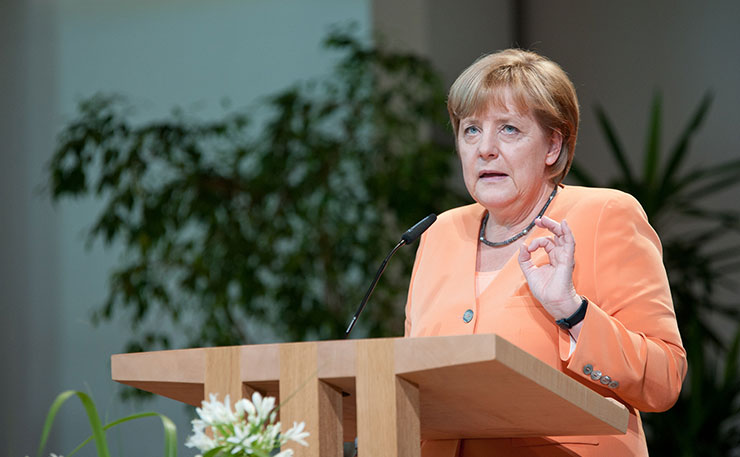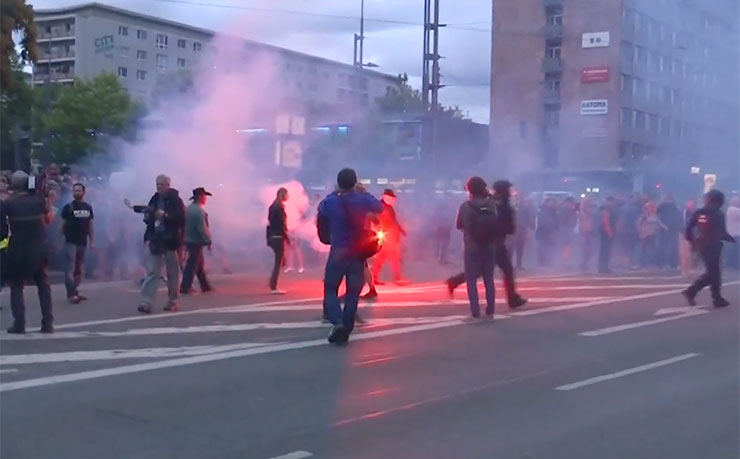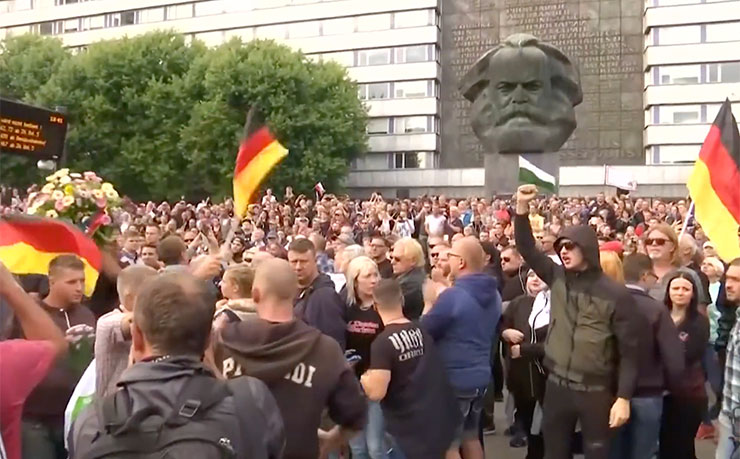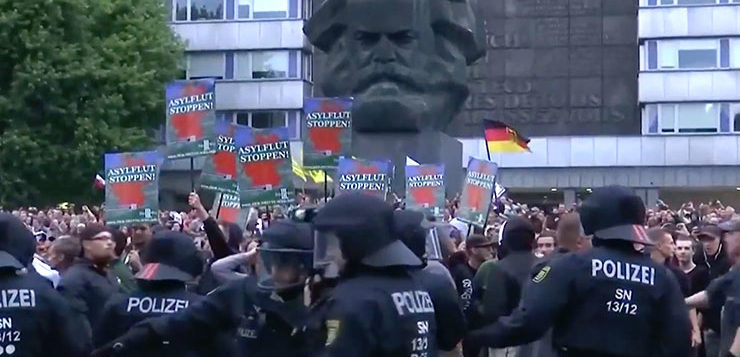Anti-migrant protests in the eastern German city of Chemnitz turned violent on Monday, adding to concerns over the far-right’s growing influence in the Federal Republic. The answer? More democracy, argues Cat Moir.
In the early hours of Sunday morning, at an annual festival in Chemnitz, a 35-year-old man was stabbed and killed when an altercation took a violent turn. According to reports, the perpetrators of the attack were one Syrian and one Iraqi man, each in their early 20s; the victim, known as Daniel H., was German-Cuban. Seizing on the attack, far-right groups organised a violent demonstration on Monday that drew hundreds onto the streets.
This was not the first instance of far-right aggression in Chemnitz in recent years. Swastikas and far-right graffiti have been popping up in the city periodically, and there were reports that neo-Nazis attempted to hijack this year’s May Day march. The fact that Chemnitz was one of only a few cities outside Dresden where the racist organisation PEGIDA had a viable chapter demonstrates that there is an audience in the city for extremist views. However, even at the height of PEGIDA’s visibility in the aftermath of the refugee crisis of 2015, its Chemnitz rallies only managed to draw between 300 and 500 people.
What happened in Chemnitz on Monday was of a different order altogether, however. While local police putting the number of far-right protesters at 800, eyewitnesses on Twitter estimated it in the thousands. Whatever the figure, an insufficient police presence was unable to cope when violence broke out after 9pm, with bottles and fireworks being thrown, and antifascists, people suspected of being migrants and journalists being attacked and threatened in the streets.
The outbreak of violence and inability of the authorities to adequately contain it have come as a shock to many in Germany. So just what caused this outbreak, and to what extent it is indicative of a broader mainstreaming of far-right politics in contemporary Germany? With these questions likely to be the subject of debate in the days to come, it’s worth examining a few of the issues in detail.
1. The far-right: on the rise?
There can be little doubt that in Germany, as elsewhere in Europe, far-right parties are seeing increased success. In last year’s Bundestag (parliamentary) elections, the nationalist anti-migrant party Alternative für Deutschland gathered just over 12% of the vote, making it the third largest party nationwide.
After protracted negotiations, Chancellor Angela Merkel secured a grand coalition between her party, the Christian Democratic Union (CDU), and the social democratic SPD. However, the fact that a radical right-wing party is now sitting in the Bundestag for the first time since 1945 is no doubt a significant — and disturbing — development for Germany, which appears to confirm that the far-right is experiencing a renewed sense of legitimacy.
However, it is important to note that according to statistics collected by the Bundesamt für Verfassungsschutz (Federal Office for the Protection of the Constitution — annual reports containing the relevant figures can be found here in German), the overall numbers of people registered as involved in radical right-wing organisations in Germany has fallen from over 51,000 in 1999 to around half that number today.

Although the number of far-right activists involved in violence has fluctuated during the same period, in 2018 it is estimated to stand at 12,700 as compared with 9000 in 1999. The increased number of far-right extremists prepared to engage in violence has not, however, translated into an increase in the number of violent incidents involving the far right. Though the number of crimes involving the far right has shown a steady upward trend since German reunification, the number of violent crimes has remained fairly stable, though with a slight increase in 2015 and 2016.
The demonstrations in Chemnitz saw a conglomeration of figures from the AfD, Pegida, and various football hooligan groups, but the action was coordinated by the Citizens Movement Pro Chemnitz, a municipal political party with ethno-nationalist values and links to neo-Nazi groups.
2. Right-wing radicalism: an ‘eastern’ problem?
Since Germany was reunified after the collapse of the Soviet Union in 1989, the eastern states, or neue Bundesländer, have struggled to catch up with the West economically, despite significant redistribution measures. More than 25 years after reunification, GDP in Germany’s east remains below that of the west, unemployment rates are higher, and more easterners than westerners feel that they are struggling to get by.
On-going disparities between east and west have historically been accompanied by visible far-right activity in the eastern states. It is no coincidence that the unrest in Chemnitz this weekend took place on the 25th anniversary of the riots in Rostock-Lichtenhagen in 1992, in which xenophobic protesters attacked an apartment block housing asylum seekers.
It was in the eastern city of Dresden that the anti-Islamic PEGIDA movement began holding weekly demonstrations in 2015. Meanwhile, the AfD has seen its greatest success in Saxony, where Chemnitz is located, taking up to 30% of the vote in some parts of the state. Attitudes towards authoritarianism also differ in east and west, with only 6% of Germans in the west viewing dictatorship favourably compared to 12% of their eastern counterparts.

However, according to the German national statistics office, the state reporting the largest number of violent crimes with far-right links since 2011 has been North Rhine-Westphalia, a former industrial heartland located in the country’s far west.
And even if at 31.5% the percentage of Germans who believe that there are too many migrants in contemporary Germany is higher in the east than in the west, that figure is nevertheless not negligible among westerners, standing at 26.5%. Xenophobia and right-wing extremism are thus by no means exclusively a problem in or for the eastern German states.
3. Violent protest: a reaction to refugees?
Certainly, there can be little doubt that the 2015 refugee crisis, which saw thousands of Syrians fleeing war and persecution arrive in Europe, contributed to a spike in far-right motivated crime. The organisers of Monday’s demonstration in Chemnitz and others on the far right such as Marcus Frohnmaier have also argued that they oppose migration. However, as so often with xenophobic sentiments, they run highest where cultural and ethnic diversity is at its lowest. As the authors of a recent study found, racist and far-right views are commonest in Germany where the numbers of migrants and refugees are smallest.
So what do the facts tell us about the reasons behind Chemnitz and the presence of far-right violence in German society today?
Despite the high visibility of events like those of Monday evening, the number of people involved in far-right groups has actually fallen in Germany over the past 20 years. That is certainly no ground to be complacent, however. If anything, the mainstream success of the AfD is a more worrying development than the persistence of fringe organisations. The AfD is not listed as an extremist party under Germany’s constitutional protection laws, and so is able to operate legally, openly appealing to xenophobic and racial-nationalist sentiments.
Because neither AfD nor PEGIDA activists are considered ‘extreme’, government statistics do not reflect the growth of such movements, which, though it may be stronger in some areas of the country than others, is nevertheless a German-wide phenomenon.
Little wonder, then, that some now see the response of the state and police authorities in Chemnitz as a test of German democracy. Merkel was swift to condemn the violence, but the profound failings of police in bringing to justice the National Socialist Underground organisation, whose members were recently convicted of a string of murders targeting actual or perceived migrants, have publicly eroded confidence in the authorities’ ability — in some cases, willingness — to combat fascism in German society.

After 1945, the critical theorist Theodor Adorno speculated that the persistence and normalisation of far-right tendencies within democratic structures was a greater threat than the resurgence of fascist movements fighting against democracy. Events this weekend in Chemnitz, which saw proponents of vigilante justice protesting alongside representatives of elected groups, demonstrate that this is not an either/or option.
The question is, how to deal with a far-right threat to democracy that operates both against and within democratic structures? The answer can only be — to quote former German Chancellor Willy Brandt — more democracy. Not in the sense of giving credence to racist views, but of defending the pluralism that extremists attack.
The evidence comes from the contradictions in which the racist right are already tangled up. Although in Chemnitz an anti-migration narrative was behind the violence, the fact that xenophobia is weaker in areas of greater diversity shows that, whatever her detractors say, Merkel’s policy of cultural openness is the right one.
Among the most astonishing scenes in Chemnitz were those of right-wing protesters in front of a monument to Karl Marx holding up banners reading ‘Foreigners Out’ in front of a relief in which the words ‘Workers of the World, Unite!’ are spelled out in German, Russian, and French.
But there is more than irony in the image of far-right banners clashing with the ideals of international openness and social solidarity that communism— for all its failings — nevertheless preached. Those ideals did not lose their value in 1989. Chemnitz shows us that they are more important than ever.
Donate To New Matilda
New Matilda is a small, independent media outlet. We survive through reader contributions, and never losing a lawsuit. If you got something from this article, giving something back helps us to continue speaking truth to power. Every little bit counts.




